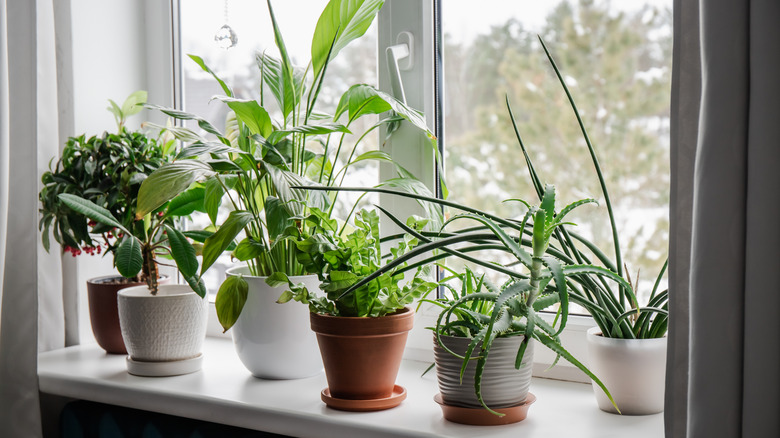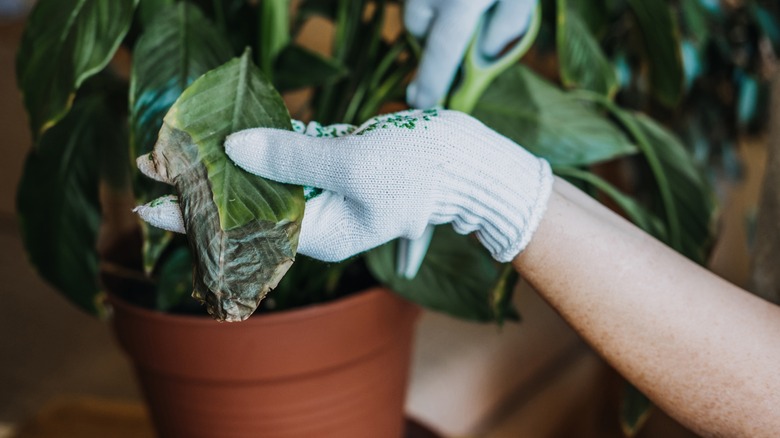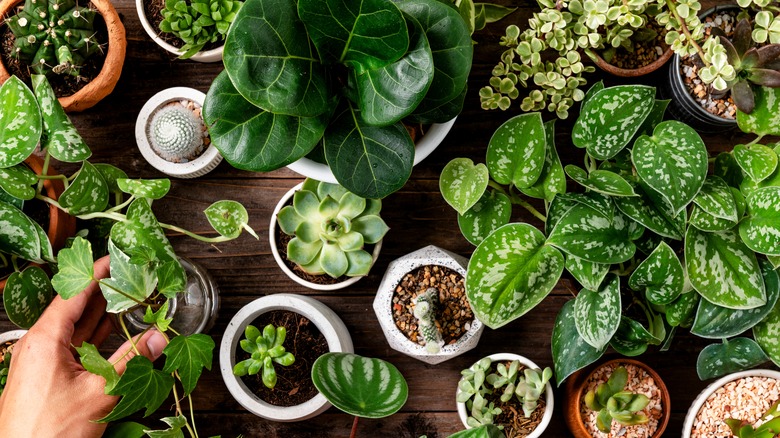Your Houseplants Need Extra TLC After A Drop In Temperature. Here's What To Do
Houseplants are notorious for being drama queens. Be honest. How many have you lost due to a shift in your watering schedule? But a drop in temperature can do so much more damage, unfortunately. With the colder season at its peak, your houseplants need a bit of extra love — especially your tropical plants. Here's a step-by-step guide to caring for even the most dramatic houseplants in your home.
Preventative measures are always the best methods to start with. Be sure to close your windows to keep away cold drafts. Cold window panes are hotspots for plants becoming dehydrated. Consider your light levels, as well. Double-glazed windows or sun lamps are exceptional options for plants that desire direct or intense sunlight. If you've done all of these things, but are still seeing tipping, frosty cracks, wilty leaves, or stunted growth, look into more extreme measures to cure your plant babies.
How to save your plants from cold damage
Cold damage may occur in two ways. When temperatures drop below a certain degree, ice crystals form on the plant's surface, causing the cells to expand or freeze. The low levels of sunlight that eventually come around quickly melt or shrink the plant's cells and destroy both its leaves and stems. Quickly pruning the plant or adding fertilizer is not a great idea. Be patient in observing your plant's behavior, as encouraging new growth during this stage may backfire.
Here's how to know if your plants are too cold. Many popular houseplants (monsteras, palms, snake plants, fiddle-leaf figs, etc.) aren't meant to experience a variety of climates. Their tropical nature craves humidity, with consistent temperatures above 70 degrees. So, extra measures are essential in the winter. Start with your watering schedule. Reduce your watering schedule to about half and be sure to wait for additional fertilizers or feedings until the spring season. Consider more advanced plant care for when spring rolls around, especially how often you should fertilize your indoor houseplants. Additional water during this time can cause a lack of oxygen and yellowing leaves. Other helpful methods to prevent damage are providing humidity or covering them with a tarp, sheet, or frost blankets.
For the most part, once a plant experiences cold damage, it's irreversible. As unfortunate as it may be to lose a plant friend, your loss will provide a greater sense of knowing for the future.
Here's what you should do for next winter
First things first, know yourself. Grab a few plants that fit your lifestyle before temperatures start dropping. If you're in need of a plant that thrives throughout the entire year or doesn't experience major declines during the winter seasons consider jade plants, aloe, succulents, ZZ plants, philodendrons, dracaenas, or pothos. Opting for a low-maintenance plant will make regulating your houseplant a bit easier in the winter. This doesn't dismiss the slight changes they'll experience when next winter rolls around.
Casey Godlove, creative director and buyer at PlantShed, a NYC celebrity plant and flower shop, recommends getting to know your plant's growth cycle, without the use of fertilizers. "Less sunlight typically sparks a plant's natural dormancy," she said to The Strategist. "They use less water, produce less new growth, and generally pause until spring."
Like all living things, a hibernation season is necessary. Let your plants rest and recover during the winter seasons, so they can blossom fully in the sunlight during the spring and summer.


